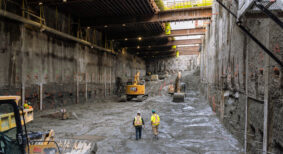Urbanization is making its mark on many large Canadian cities. With populations in major metropolitan areas consistently growing, increasing traffic demands are putting an added strain on aging infrastructure.
With existing transportation routes built for very different infrastructure needs and requirements, conditions are deteriorating and cannot be sustained for much longer.
Whether to rehabilitate or construct new infrastructure is a dilemma that many owners face, and both options come with their own special challenges. However, when demolishing an old structure and constructing a new one is not an available option, owners must look for long-term rehabilitation solutions. This situation especially rings true for the aging bridges across the nation.
For this reason, developing advanced rehabilitation techniques and optimizing service life design has become exponentially more important as outdated infrastructure becomes more and more commonplace.
Engineering innovations
Buckland & Taylor | COWI (B&T) has been heavily involved in major bridge rehabilitation projects since 1972. With this involvement have come multiple advancements in detailed rehabilitation design technologies including seismic innovations.
In order to address the challenge of optimizing and maintaining the service life of bridges in the most cost-effective way possible, B&T has developed unprecedented design and erection engineering schemes to replace the entire suspended structure of major suspension bridges. This complex procedure has become revolutionary throughout the industry for its technical, aesthetic and holistic solution towards deck rehabilitation. It involves replacing the entire suspended structure of the bridge in segments during nighttime closures, and re-opening the bridge again to the commuter traffic rush each morning.
Our first experience with such a complex redecking project was in 2001 on the Lions’ Gate Bridge in Vancouver, B.C., where we carried out the final bridge design and acted as the owner’s engineer during construction, reviewing the contractor’s erection scheme. On the Macdonald Bridge project, we not only designed the final bridge, but also developed the sequences to be followed by the contractor during erection.
Extending the life of a Nova Scotia legacy
Angus L. Macdonald Bridge or the “Old Bridge,” as it is locally known, is a lifeline of the metropolitan City of Halifax, Nova Scotia, providing vehicles, cyclists and pedestrians with access to the downtown core since 1955. The design of the bridge redecking addressed the major challenges associated with extending the life of the bridge, and in doing so improved the transportation route for the local community.
The suspended portion (including 46 deck segments, stiffening trusses and hangers) of the Macdonald Bridge underwent a full deck replacement during 10.5-hour nighttime closures, and was re-opened each morning to traffic.
The severe Halifax wind climate, the urban location, and the proximity to Department of National Defense – Forces buildings directly below the construction area, have posed significant challenges throughout the design process.
During a typical installation cycle, existing 20 m (65 ft) long deck segments (weighing approximately 150 tons each) are cut free and lowered onto a barge. A new, pre-fabricated segment is lifted into place and is connected, first to the old and then to the previous new deck segment. In the case of the Macdonald side spans on the Halifax end, where the bridge is above Department of National Defense – Forces property, 10 m (33 ft) long segments were supplied and removed by a transporter on the bridge, rather than being supplied and removed from below.
Upon completion, in a unique operation, the bridge will be gradually lifted to result in an increased shipping clearance of 2.9 m (10 ft) at mid span. This will allow larger ships to pass underneath to access nearby port facilities, thereby increasing port business and competiveness.
A very important feature of the project is the benefits that come with the focus on increasing service life design. Our durability methods are giving old bridges a second chance at life. In the case of Macdonald Bridge, our design reduces maintenance and enhances sustainability in four ways. These include: using smooth welded joints to replace the existing riveted ones (reducing costly crevice corrosion); reducing the area to be painted by half; ensuring that almost all the steel to be painted is under the deck, protected from deicing salt spray; and installing a main cable dehumidification system to effectively protect them from corrosion.
This type of rehabilitation project also brings a number of benefits to the economy and surrounding community.
Together, the travelling public, stakeholders, owners and contractors share in the benefits. These include: minimizing effects on traffic with no interruption during peak demand hours Monday to Friday; providing an entire, brand new suspended structure; reducing the demands on the main cables and towers due to a lighter replacement deck (resulting in a greater safety factor for the major existing bridge elements); providing wider roadway lanes, and improved and more durable pavement; increasing the vertical clearance for ships; providing a quieter route due to new, smoother expansion joints; and providing greater aerodynamic stability with a stronger deck structure.
Such a complex feat of engineering also attracts attention from around the world that is sure to have a lasting effect on the economy through increased business and additional engineering and construction jobs. In addition, long-span bridge engineering technology is being transferred to the region, which fuels innovation in the profession.
Constructing the future
Aging transportation infrastructure may be challenging our nation, but by continuously developing innovative and cost effective engineering techniques, owners can be assured that using careful, creative engineering to arrive at suitable rehabilitation options can provide the long-term solutions that they require.
Keith Kirkwood, P.Eng., is chief project manager at Buckland & Taylor | COWI in North Vancouver, BC.










